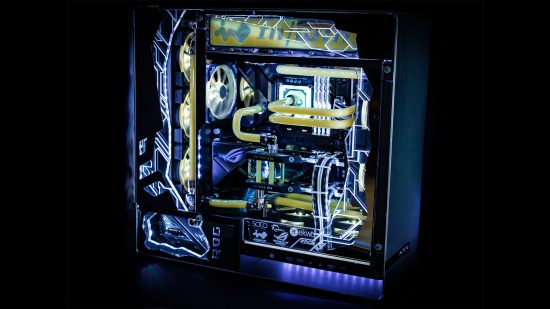This water-cooled gaming PC looks like it was mined out of the rock by a very lucky geologist. Armed with a CNC machine, plenty of acrylic sheet and some expert 3D modeling skills, PC modder Søren Kirkegaard made this striking build inspired by the look of Citrine crystals.
Thanks to our rapidly growing PC building Facebook page, we’ve seen many custom gaming PCs, from mods based on existing case designs to scratch PC builds. You can even submit yours for consideration right here. Here we talk to Søren about how he transformed his In Win 909 PC case into a crystalline beauty.
PCGamesN: How did this project start?
Søren: It started out with the idea of putting hard tubing in my current rig. At that point, I already had a soft tube-loop in the same case. I started to draw it all up in 3D, which is what I tend to do when I start a new project. My original idea was to make a new theme based around crystals and their colors. The hard edges, crystal look and yellow color all came from the stone I chose for this theme – Citrine!
What case did you choose and why?
I chose the In Win 909, which was the case I used in my previous build, and I love the look, size and possibilities for it. There’s space for three radiators inside it, which I felt I needed for this amount of hardware. I had been looking at the case for a year or so, and I imagined different ways to integrate a water-cooling system directly into the case. I created a 3D virtual model first, so I could try out different ideas and see what was actually possible.
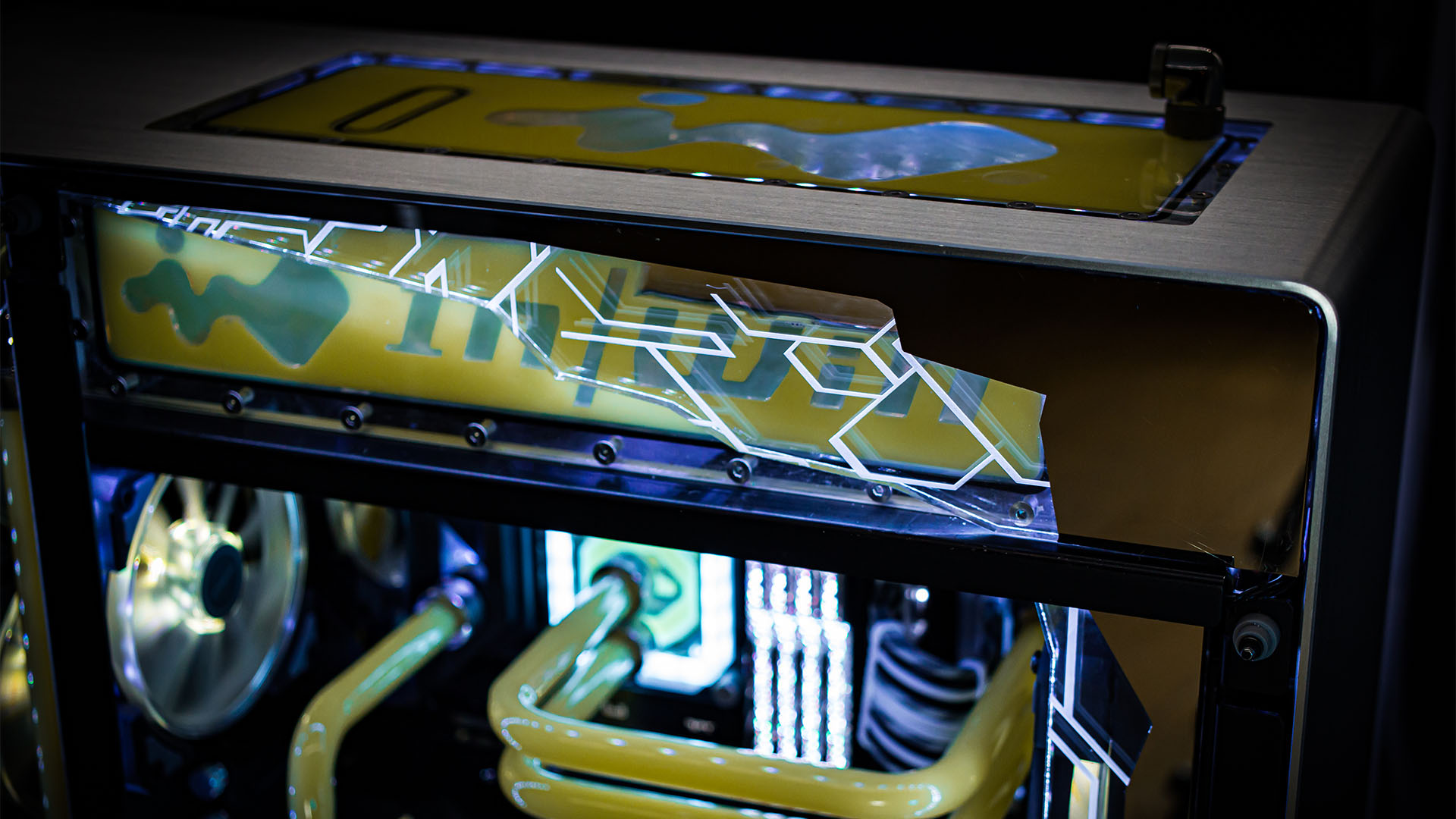
We love the broken rock/crystal effects around the graphics cards and PSU shroud area. How did you achieve this effect?
All my so-called ‘light signs’ are custom-designed and made. I started out with my 3D model, trying out different designs. Afterward, I had the signs cut and laser-etched in 8mm clear acrylic. All the signs have mirror-polished aluminum on them to hide the RGB strips and give them a mirror finish. All these light signs are controlled by the Asus Aura Terminal and then connected to the motherboard, so they can synchronize with the lighting in the rest of the build.
All the etched patterns catch the light, plus you see the light on the clear edges. That’s the effect you get when there’s only light on the etched parts, and the rest is just clear – it looks damn cool! My brother, who has helped me a lot in the manufacturing of parts, helped me to 3D-print the RGB brackets and assemble the signs. The light signs have three layers overall – the 3D-printed part, then the acrylic and then the aluminum.
Did you have to physically modify the case?
I decided to mount my pump/reservoir combo unit horizontally, on the top of the case, so I was able to see the fluid on the top side. For this, I first designed a pump/res combo. Then my brother and me CNC-machined it, which wasn’t easy, plus we had to implement a pump and make our own pump bracket. It took some time.
When that was done, we measured the hole we needed to cut out in the top of the case. We used the CNC machine, and very slowly the hole finally got cut out. We then mounted the pump/res combo using 3D-printed brackets and magnets, so it sits in place but can still be removed if necessary.
There are also lots of small 3D-printed parts in this build that you can’t see, which I’m pretty happy about. One of them is the stand for the Asus Aura Terminal, on top of the PSU area. It’s designed so that it hides the cables from the PSU and the RGB cables connected to it – it’s barely visible; you can just see the Asus logo light up in the bottom.
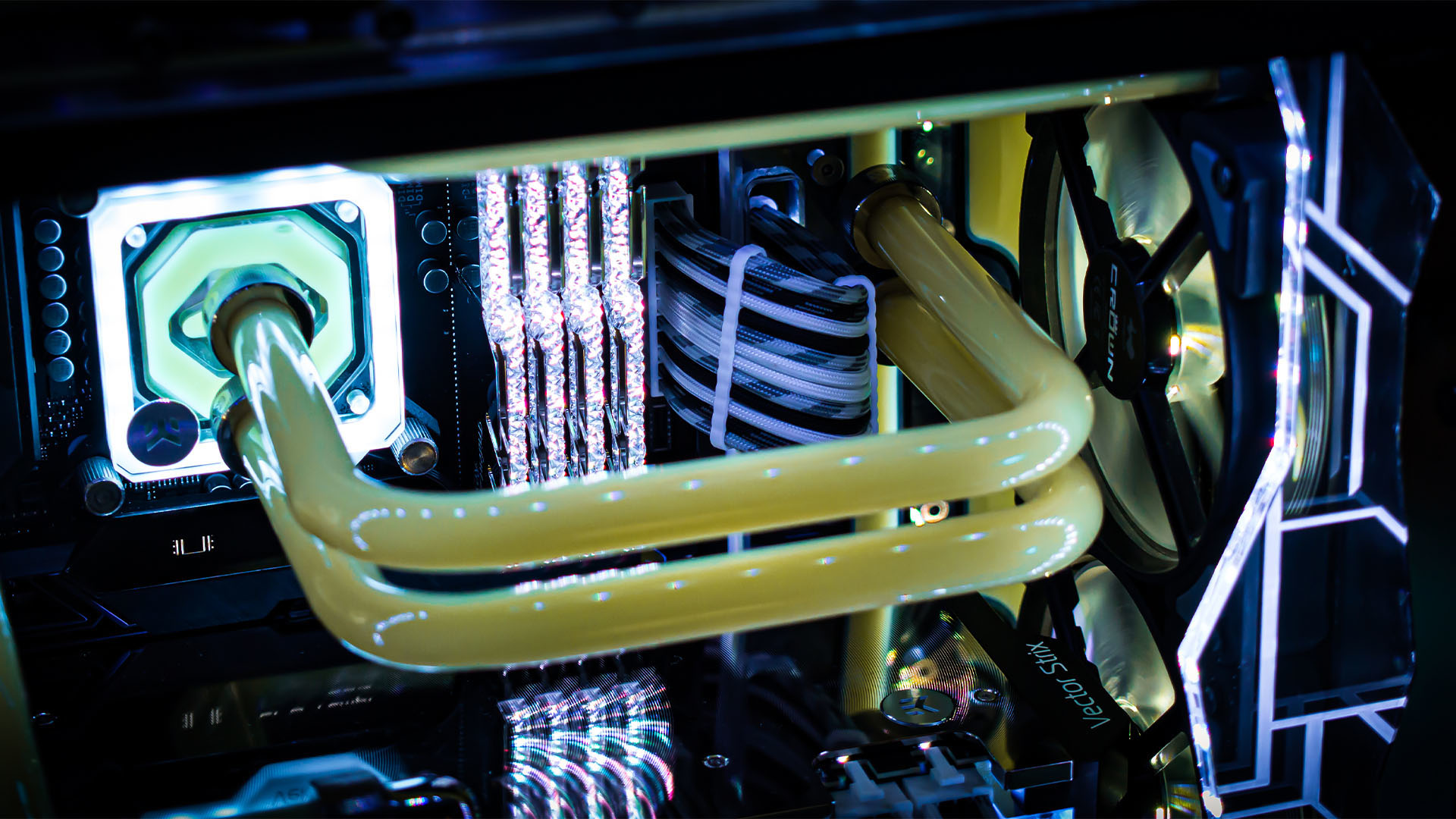
How did you plan the cooling system?
I designed it all in 3D beforehand. I designed the entire PC, with all the hardware, cooling, cables and so on, and then planned my loop in 3D. As a result, I had a plan and a design before I even had the parts in my hands. Of course, there were always going to be some changes along the way, but the end result came out very close to my original idea. The tubes are acrylic, and they were all shaped and bent by hand.
That’s some neat cabling for a dual-GPU build with so much lighting. Where did you get the custom cables, and how did you plan the cable routing?
I got my cables from Solo Sleeving, a one-man company in the USA. The cables were made as a direct replacement for the stock cables and I had them made to the exact length I needed, which made it so much easier to manage the ‘bigger’ cables.
All the ‘small’ cables, for the fans, storage, temperature sensors and so on, are neatly tucked away and guided by cable combs. I routed all the cables for the RGB lighting (there are a lot in this build) last, so I had easy access to them in case any of the strips failed.
You don’t often see SLI graphics setups these days. What graphics cards are you using here, and what performance do you get from them?
I have two Asus ROG Strix OC GeForce RTX 2080 Ti cards in this system, in SLI mode (using NVLink), for rendering purposes. I render on my GPUs, and using these cards with ray tracing provided an awesome improvement in render speed over my old GTX 1080 Ti cards. Some games can handle the SLI config, and with others it’s best to just disable one of the cards, but the setup does make sense for my work.
Take us through the water-cooling system.
This water-cooling system is cooled by three radiators. There’s a 60mm-thick 360mm radiator in the back and two 28mm-thick 240mm radiators in the front and bottom. The back radiator is set up in a push/pull configuration, and the two 240mm radiators draw cold air into the case.
This build also has two custom distro plates and the custom res/pump combo unit on the top that I mentioned earlier. Just underneath that sits a distro/res unit that acts mostly as an aesthetic piece, which says ‘InWin’ on it. The inside of the case has another distribution plate, which connects all the runs and helps me tidy it all up.
All these custom pieces were designed in Fusion 360 and manufactured on a small CNC machine. My brother and me had to spend some very long nights getting this all right, since it was our first time trying to make parts such as these ones. We had to remake both the distro plates two times, but I’m very happy with the results.
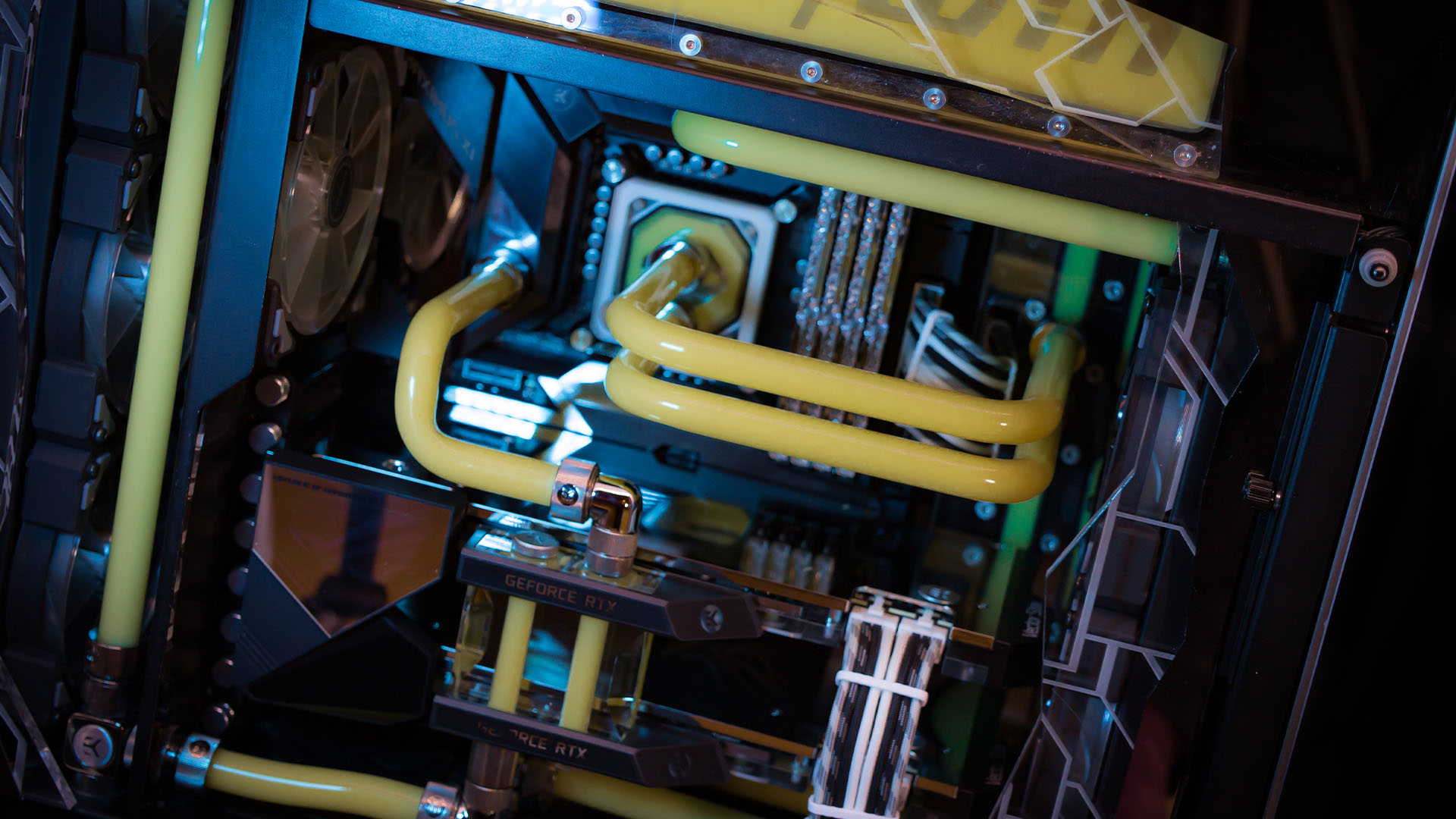
What coolant did you use, and why did you choose that combination of yellow coolant and white lighting?
The coolant is EKWB Laguna Yellow, and it sits very well with the theme color, which is based on the stone Citrine. The white light is there to help create the complete crystal look I was aiming to achieve.
What temperatures do you get on the CPU and GPU with that water-cooling setup?
The maximum temperature on my CPU is 54°C, and my two GeForce RTX 2080 Ti cards max out at 55°C.
Did you come across any difficulties?
The most difficult part of this build was manufacturing the custom acrylic parts. I had to learn how to integrate a pump into the reservoir (thank god for YouTube). Then I had to learn how to make toolpaths for a CNC machine, and of course learn how to use the CNC machine.
Luckily, my brother took care of the last part, and then we helped each other to get it all to work together. It involved a lot of trial and error – this part of the build was, without a doubt, the most time-consuming part, but I learned a lot of skills that I’ve used in later builds.
How long did it take you to complete this build?
From creating my first drawings to the finished build, I’ll say roughly six months, but I think it took two months from when we started building it.
Are you completely happy with the end result, or do you wish you’d done some of it differently in retrospect?
I’m very satisfied with this build! I got to implement all my ideas into it and I was lucky enough to get the parts that I wanted. I learned a lot in the process, and I’m very satisfied with Citrine.
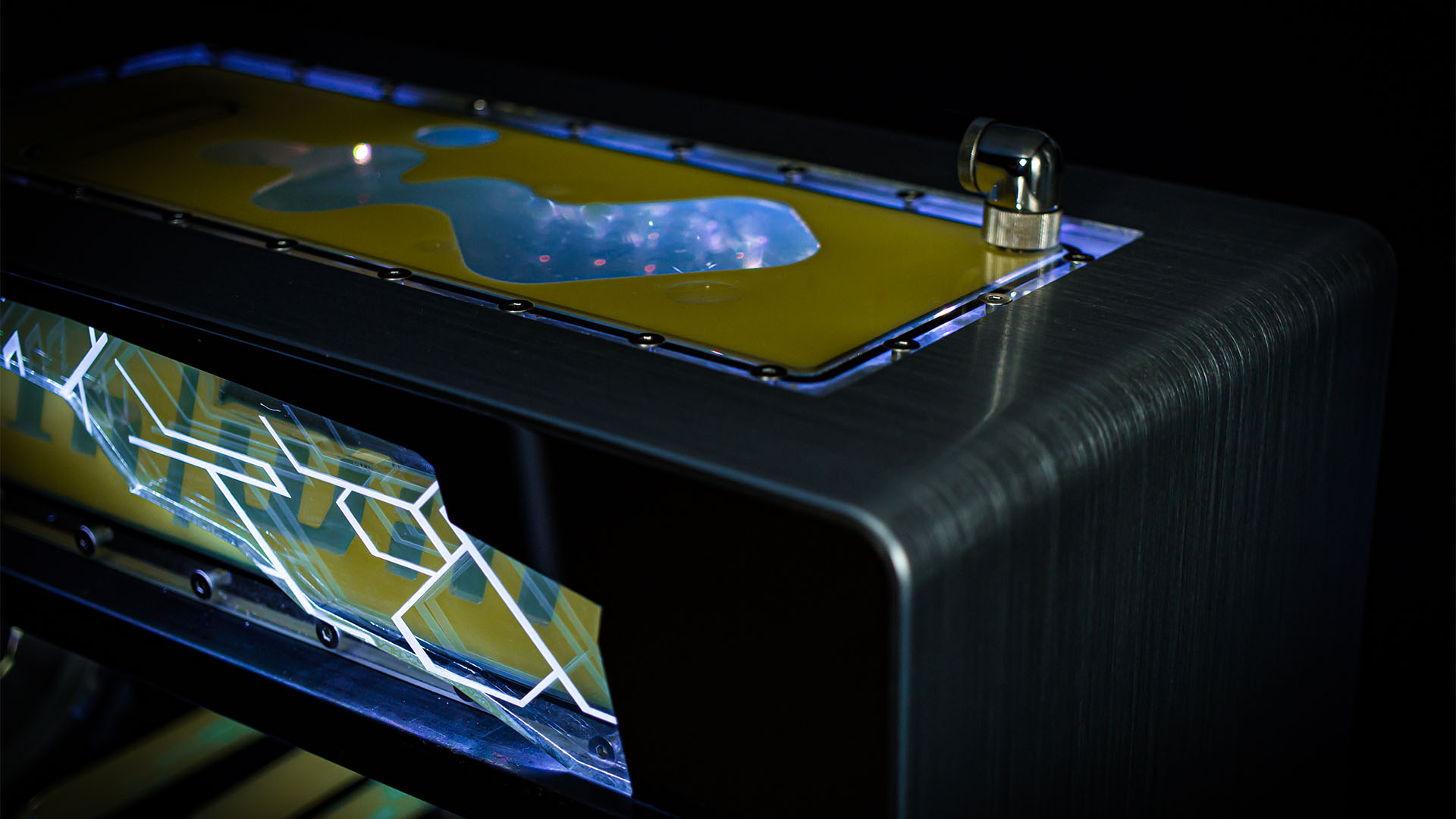
Citrine water-cooled PC specs:
- CPU: Intel Core i7-8086K overclocked to 5.2GHz
- Case: In Win 909 Silver
- GPU: 2 x Asus ROG Strix OC GeForce RTX 2080 Ti
- Storage: 500GB Samsung 960 Evo, 2 x 1TB Samsung 860 Evo
- Memory: 64GB G.Skill Royal Silver 3600MHz
- Motherboard: Asus ROG Maximus XI Formula
- PSU: Asus ROG Thor 1200W
- Cooling: EKWB Velocity CPU waterblock, EKWB Vector GPU waterblocks, 3 x EKWB radiators with 8 x InWin Crown fans, 3 x EKWB Vardar EVO fans
This is a cracking case mod, Søren! You’ve done a great job with the laser-cut acrylic sheet to make crystal effects, and we love the hard-tube water-cooling loop filled with yellow coolant. If you’re new to the world of water-cooling and want to have go yourself, then make sure you also read our full guide on how to water cool your PC.
This post originally appeared on Custom PC, which has been covering amazing setups for over 20 years and is now part of PCGamesN. Join our nearly 500k member Facebook group to discuss this build.
If you consider yourself to be an expert PC builder, you can submit your own custom PC build to us today for a chance of being featured on PCGamesN in the future.
